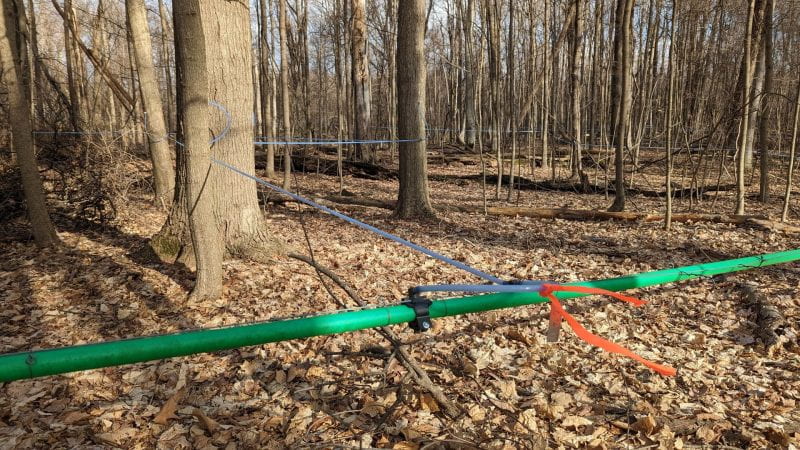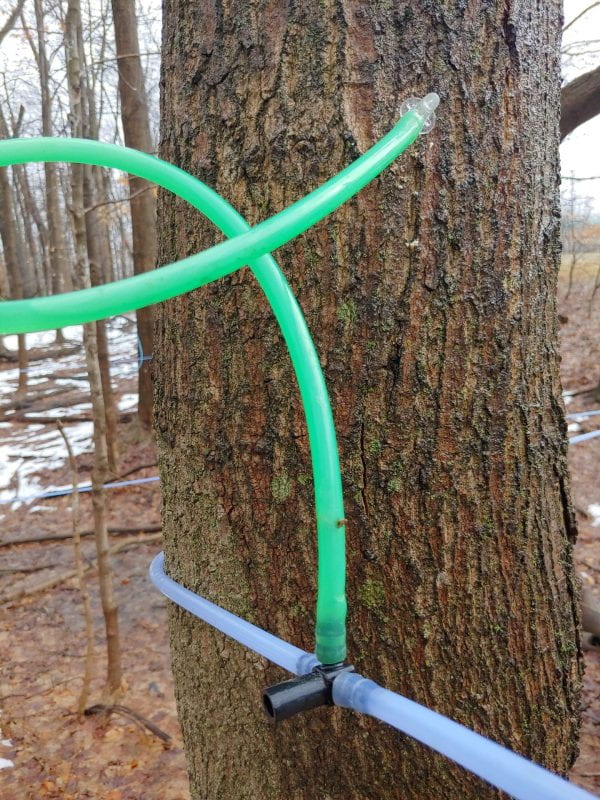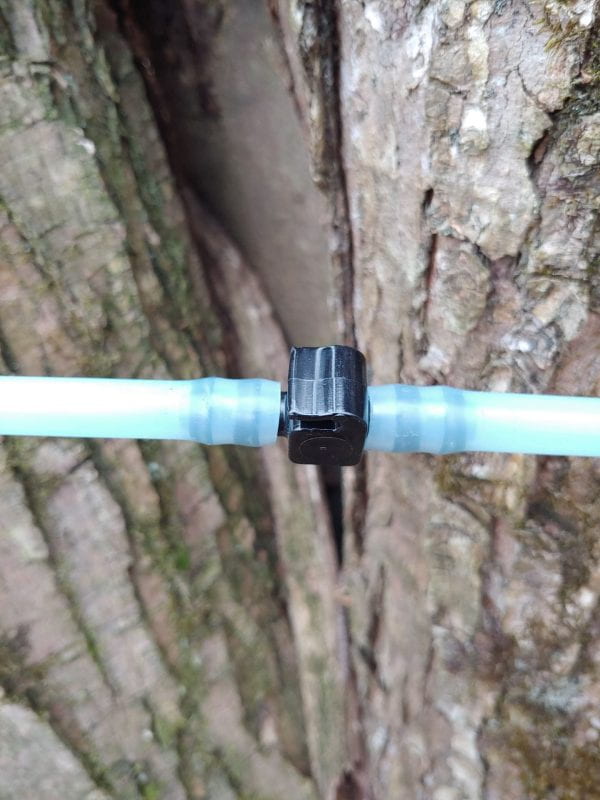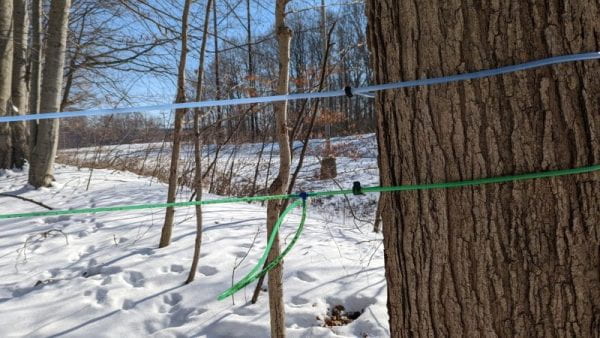The goal of these next 3 articles is for you to realize that there are many factors that go into installing and running a maple vacuum tubing system. All the factors are interrelated and each one needs to be careful considered on the part of the operator. The below information is contained in the Cornell New York State Tubing and Vacuum System Notebook (NSTVN) written by Cornell University’s Maple Specialist Steve Childs. Much of the information is this and the next two posts is a synthesis of past content with some more recent best practice guidance.
When we talk about tubing systems, we have two roads to travel. One is a gravity system and the other is a vacuum system. A conventional 5/16” gravity system is not much different from running sap into a bucket. The yield is much the same as collecting sap in a bucket. When we add vacuum to a tubing system, we increase the sap yield 5% for every inch of vacuum we generate in our system. For example, if we produce 15 inches of vacuum in a line, we should be able to almost double our sap yield. The first year after installation is always the best. As time on a system accumulates, wear-and-tear hampers performance.
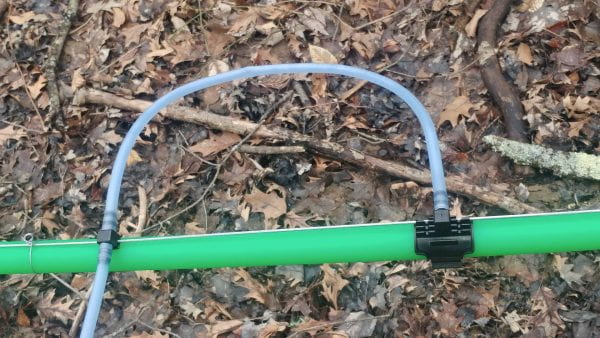
Caption: Year 1 Production with a Brand-New System Should Provide Your Best Vacuum Levels
The definition of vacuum is the absence of air. The maximum level of vacuum achievable on any given day is determined by the barometric pressure. This means that our vacuum level can never exceed the barometric pressure in the location of our sugar bush. There are two way to measure vacuum pump performance, Inches of Mercury (hg) and Cubic Feet per Minute (CFM). Inches of mercury measures the negative pressure produced when air leaves the line. For example, if 50% of the air is removed then the inches of mercury should be somewhere between 14 and 15. At 25 inches of mercury, approximately 85% of the air has been removed from the lines. CFM on the other hand measures the amount of air being evacuated from the lines in units of cubic feet per minute. This is the amount of air that a vacuum pump is pulling out of the system in one minute’s time. Where is the air coming from? The answer is gas that is forming inside the tree and being expelled through the tap hole. As a rule of thumb, there is a 1 CFM requirement for every 100 taps on the line. However, the biggest contributors are leaks allowing air to enter the system through damaged or aging tubing. This statement emphasizes the importance of managing leaks in a vacuum tubing system.
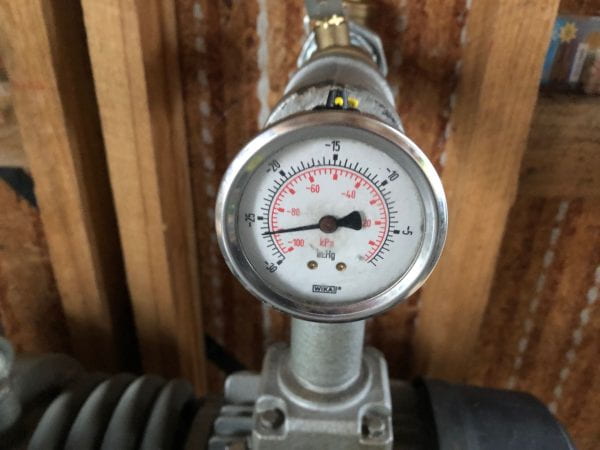
Caption: Vacuum Gauge Measuring Vacuum in Inches of Mercury (hg)
Speaking of leaks, the most important part of operating any maple syrup system is the time you spend in the woods making sure your vacuum tubing system is leak-free. Much of the rest of the article is spent discussing different technologies and equipment, but the simple fact of the matter is this – the best equipment with poor care in the woods won’t do you a lick of good when it comes to putting more maple syrup on tables of your customers. You must always account for leaks that introduce air into lines. You might be able to maintain peak vacuum on average days, but your system will show its weak points when sap flows are running fast and you need to move as much as air as fast as possible to maintain vacuum levels. Being able to spot and repair leaks quickly is essential. To accomplish this, you should design your system so you can isolate lines to pinpoint problems. This can be done by compartmentalizing your system with valves and vacuum gauges placed at the starting point of each line. The installation of a tubing monitoring system can be a wise investment as well, and the time saved and extra sap produced will pay for the cost of the upgrades in short order.
Back to our lesson on vacuum and barometric pressure. There are factors that have a direct effect on barometric pressure. One is altitude. As the altitude increases the maximum barometric pressure declines (rule of thumb: for every 1000 feet of elevation you lose 1 inch of vacuum). For example, at sea level, or 0 altitude, the average barometric press can be 29 inches; at 2000 feet, the average maximum barometric pressure obtainable is only around 28 inches. In addition, barometric pressure changes under different environmental conditions, and variations in barometric pressure caused by atmospheric changes can occur multiple times in a day. If we are running a vacuum pump under a low barometer at 2000 feet elevation, we might struggle to maintain 28 or even 27 inches of vacuum on a very tight well-maintained tubing system.
Sap moves down the line by gravity on a system of tubes suspended with wire. The basic components are spouts, tees, and drops moving sap from the tree into lateral lines. A lateral line should have no more than 5 to 10 taps per line and should be no longer than 100 feet in length. The lateral lines flow into main lines. In large systems, secondary mains flow into Wet-Dry lines and or trunk lines (large diameter lines) that move the sap to a central collection point. To properly function, sap lines should be straight, pulled tight, and sloped downhill. To this point gravity systems and vacuum systems are similar, with the gravity system relying on slope and Newton’s law of gravity to move the sap.

Caption: 65 CFM Bush R-5 Vacuum Pump
When vacuum is added to the system, sap flow is aided by the movement of air. The components of a vacuum tubing system are the vacuum pump, which is connected to lines via a sap releaser. Even though it is called a vacuum pump, it is not a pump in the conventional sense of the word and that is a bit confusing. A conventional pump moves liquid creating pressure ahead of the liquid and suction on the backside of the liquid. There are other types of pumps used in maple production. For example, a diaphragm pump is a conventional pump and that creates enough suction (secondary vacuum) to draw sap from a tree. However, if liquid is not present in the lines that suction can be lost. A true vacuum pump moves air, not liquid and it creates a higher level of vacuum (absence of air) as the air is removed from the lines. That level of vacuum can be maintained with or without sap in the lines and will only drop if a leak allows outside air to enter the line. Because the pump is designed to move only air, the liquid must be separated from the pump. This separation process is performed by a sap releaser. If sap enters the vacuum pump severe damage to the pump can occur! To prevent this from happening, a moisture trap is placed between the pump and the releaser.

Caption: Sap house releaser (right) with Vacuum Piston Pump (left)
A properly sized vacuum pump with a proper CFM rating will be capable of removing air faster than it is introduced. However, there is one factor that can interrupt and slow that process – line size. Vacuum lines are designed to conduct air to the pump. If your line diameter is too small, the air movement will be restricted requiring more time for the pump to clear air from the lines. This phenomenon is referred to as line loss. The smaller the line the more the air flow is restricted resulting in higher line loss. As an example, a 60 CFM pump set at 15 inches of vacuum hooked to a 3“ line can maintain over 40 CFM out to 5000 feet. However, that same pump hooked to a ¾” inch line is incapable of delivering 15 inches of vacuum at 2500 feet from the pump. Line loss increases the time (recovery time) needed to evacuate air from the line and restore peak vacuum level.
What is missing from this equation? The capacity of the line to conduct liquid. Every diameter of pipe has a maximum liquid capacity. The size of the pipe that is needed is determined by the number of taps flowing into the pipe. Each tap during a peak flow might contribute upwards of 0.2 gallons of sap per hour. Once you calculate the amount of sap flowing in you can determine the size of the pipe that is needed. There is however one caveat, the steeper the slope the faster the sap moves through the line thereby effectively increasing the capacity of a given-sized line on steeper slopes. Slope can also influence sap flow in other ways. The portion of the line, 50 feet or longer with the least amount of slope, will strongly influence sap flow. Examining this critical portion of your line might dictate a necessary increase in line diameter to allow for adequate air and liquid flow. Remember, you need to move air as well as liquid through a maple pipeline. To do this you must maintain the proper ratio of air to liquid inside the line so as not to inhibit sap movement. If you look at a working cross section of tubing it should contain 60% air and 40% liquid. This is a primary consideration when determining what size of line to use in your sugarbush. If the liquid level increases beyond that ratio or is uneven (wavy), the air movement will be restricted resulting in a drop in vacuum.

Caption: Whip Connection to a Wet-Dry Line.
There are two ways to solve this problem. The first would be to increase the size of your main lines but 1 ½” inch and 2” tubing is expensive, and it adds to the overall expense of the tubing system. Still, increasing tubing size may be justified if you have a large number of taps coming into a trunk line. The other alternative is to install a dual-line conductor commonly known as a Wet-Dry Line. Composed of two lines of equal size (or a dry line slightly larger than the wet line), a Wet-Dry system can excel at moving sap across flat areas or areas where multiple secondary mainlines merge. Secondary mains may enter the Wet-Dry line at a booster, or a line configuration called a whip. This allows sap to move down the wet line without impeding the airflow in the dry line. This set-up is particularly useful in flat areas where slope in minimal and sap flows slowly which may inhibit the necessary amount of air flow. Wet-Dry lines can be a cost-effective way to move sap through areas of minimal slope.
Stay tuned for Part II in a couple of days and be sure to leave questions or comments!
Author: Les Ober, Geauga County OSU Extension 



